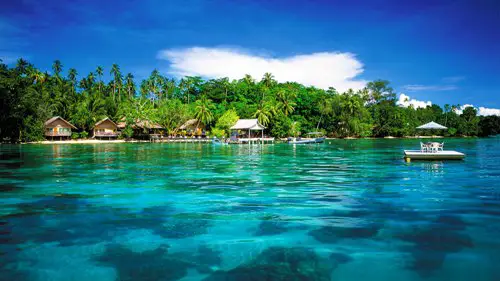The Solomon Islands, a diverse archipelago located in the South Pacific, is often overlooked as a travel destination. However, it is rich in culture, wildlife, and history. Here, we delve into two intriguing facts about this captivating nation, shedding light on its distinctiveness in the realms of biodiversity and cultural heritage.
Biodiversity Hotspot
The Solomon Islands are celebrated for their extraordinary biodiversity. As a part of the Coral Triangle, a marine area recognized for its high aquatic species richness, the islands host an abundance of marine life and unique terrestrial ecosystems. With over 30,000 square kilometers of coral reefs surrounding them, the waters provide sanctuary for thousands of species of fish, crustaceans, and mollusks. This vibrant marine environment is the lifeblood of the local economy and sustains the livelihoods of many indigenous communities.
Delving deeper into the marine life, the biodiversity of the Solomon Islands’ coral reefs is home to approximately 550 species of coral. This staggering variety supports myriad marine organisms, including some of the world’s most endangered species. Among them are the Hawksbill sea turtle and the Dugong, both of which contribute to the islands’ ecological balance. The presence of such wildlife not only emphasizes the islands’ environmental significance but also underscores the urgent need for conservation efforts to protect these fragile ecosystems.
On land, the Solomon Islands boast an impressive array of flora and fauna. With about 6,000 species of plants, many of which are endemic, the islands feature a kaleidoscope of landscapes, from dense rainforests to rugged mountains. Among the notable species are the unique bird populations, including the critically endangered Solomons rainforest kingfisher and the colorful Raggiana bird of paradise. This avian diversity captivates ornithologists and nature enthusiasts alike, drawing attention to the islands’ role as a refuge for species that are otherwise declining worldwide.
Furthermore, the diverse ecosystems support a range of indigenous practices that have been honed over centuries. Traditional fishing techniques, sustainable agriculture, and the use of indigenous plant species for medicinal purposes demonstrate how biodiversity is intimately tied to the cultural fabric of the islands. The Solomon Islands are not merely a backdrop of stunning vistas but are also a repository of biological knowledge that warrants exploration and preservation.
Cultural Tapestry
One of the most fascinating aspects of Solomons culture is the practice of “singsing,” a vibrant and colorful celebration featuring traditional music, dance, and costume. These events are more than mere entertainment; they serve as a means of preserving oral history and reinforcing community bonds. During a singsing, participants don elaborate attire made from natural materials, showcasing the ingenuity of indigenous craftsmanship. The significance of these gatherings extends beyond immediate enjoyment; they also play a pivotal role in passing down folklore and cultural values to younger generations.
The Solomon Islands also maintain a variety of traditional rituals, many linked to agriculture, fishing, and other subsistence activities. For instance, the “nasara,” a ceremonial feast, occurs to mark the harvest and is typically accompanied by singing and dancing. Such events encapsulate the deep-rooted connection between the people and their environment, reflecting a profound respect for the natural world. The emphasis placed on communal participation reinforces social cohesion and a collective identity that is crucial in maintaining their cultural heritage.
Additionally, the islands’ history of interaction with various colonial powers has left enduring imprints on the local culture. The arrival of missionaries in the 19th century introduced new religious practices and educational frameworks while also spawning a rich tapestry of syncretic beliefs. Christianity coexists with ancient traditions, resulting in a spiritual landscape that is both diverse and complex. This mélange of influences is especially visible in local art, music, and handicrafts, which often incorporate both indigenous themes and Western motifs.
In conclusion, the Solomon Islands are a microcosm of biodiversity and cultural richness. From their unique ecosystems that house a myriad of endemic species to the vibrant cultural expressions that define the lives of its people, these islands present a fascinating case study of how humanity and nature can coexist in harmony. As awareness grows about the intrinsic value of such places, continued efforts toward conservation and cultural preservation will be essential in safeguarding the future of the Solomon Islands.









